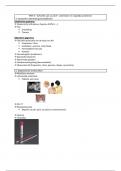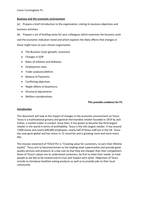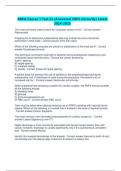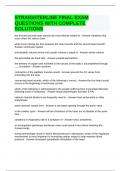Chapter 4
Mass balances in systems with
chemical reaction. Ideal reactors
Outline
Chapter 4. Mass balances with chemical reaction
1. The chemical reaction
2. General equation of macroscopic mass balance in systems
with chemical reaction
3. Mass balances in steady-state systems with chemical reaction
• Continuous stirred tank reactor
• Continuous plug flow reactor
4. Mass balances in unsteady-state systems with chemical reaction
• Discontinuous stirred tank reactor
, 1. The chemical reaction: stoichiometry
•The chemical reaction is the unit operation that aims to distribute in a different way
the atoms of some molecules (reacting compounds or reactants) to form new ones
(products).
Stoichiometry
•The chemical equation provides essential both quantitative and qualitative
information to calculate the amounts of substances involved in a chemical reaction.
• A chemical reaction must be balanced, that is, the number of moles of atoms in the
reactants must equal the number of moles of atoms in the products.
•The numbers used to balance a chemical reaction are called stoichiometric
coefficients (j), which will be positive for the products and negative for the reactants.
1. The chemical reaction: stoichiometry
Example
Synthesis of ammonia:
N2 + H2 NH3
1/2·N2 + 3/2·H2 NH3
The stoichiometric coefficients are:
• N2 = -1/2
• H2 = -3/2
• NH3 = 1
N2 + 3·H2 2·NH3
The stoichiometric coefficients are :
• N2 = -1 Mass balances with chemical reaction
• H2 = -3 must be solved in molar units and,
subsequently, the results can be
• NH3 = 2
expressed in molar or mass units.
, 1. The chemical reaction: stoichiometry
If 10 kg of nitrogen react completely with a stoichiometric amount of hydrogen, how
many kg of ammonia are produced?
However, in real industrial reactors, the following events are common:
• The reactants are not in stoichiometric quantities, but some are in
excess.
• The reaction is not 100% complete, but a certain degree of conversion is
reached.
• Side reactions can also occur.
1. The chemical reaction: stoichiometry
•Limiting reactant: is the reactant that is in less quantity than that of stoichiometric
proportion, and therefore, it is consumed first during the reaction, limiting the
formation of more products. k is the limiting reactant if all other reactants j meet the
following requirement: Nj Nk Cj Ck
If V= constant
j k j k
•Reactant (s) in excess: the reactant(s) that participate in the reaction but not as
limiting reactant. Therefore, when the reaction finishes, there is an amount in excess
of them. The excess percentage of a reactant is based on the amount of the reactant
in excess with respect to the amount required to react with all limiting reactant
according to the chemical equation:
% excess moles in excess
100
moles required to react will all limiting reactant
•Air in excess in combustion reactions: excess air above that necessary to burn
completely all combustible material.
, 1. The chemical reaction: stoichiometry
Example 1
Ammonia (NH3) reacts with carbon dioxide (CO2) to give urea (CH4N2O) and water.
How many grams of urea will be obtained if 637.2 g of ammonia are mixed with
1142 g of carbon dioxide? Which is the percentage of the excess reactant?
1. The chemical reaction: stoichiometry
•Selectivity: ratio between the number of moles of the desired product and the
number of moles of the undesired product.
•Yield: ratio between the mass/moles of a final product and the mass/moles of a
reactant. In case of several reactants/products, the referred reactant/product yield
must be specified. Other definitions:
• Theoretical or maximum yield: amount of product that is predicted by the
balanced chemical equation when all the limiting reactant is consumed.
• Reaction yield: it is the amount of product that is actually obtained. The
reaction yield is always lower than or equal to the theoretical one.
Mass balances in systems with
chemical reaction. Ideal reactors
Outline
Chapter 4. Mass balances with chemical reaction
1. The chemical reaction
2. General equation of macroscopic mass balance in systems
with chemical reaction
3. Mass balances in steady-state systems with chemical reaction
• Continuous stirred tank reactor
• Continuous plug flow reactor
4. Mass balances in unsteady-state systems with chemical reaction
• Discontinuous stirred tank reactor
, 1. The chemical reaction: stoichiometry
•The chemical reaction is the unit operation that aims to distribute in a different way
the atoms of some molecules (reacting compounds or reactants) to form new ones
(products).
Stoichiometry
•The chemical equation provides essential both quantitative and qualitative
information to calculate the amounts of substances involved in a chemical reaction.
• A chemical reaction must be balanced, that is, the number of moles of atoms in the
reactants must equal the number of moles of atoms in the products.
•The numbers used to balance a chemical reaction are called stoichiometric
coefficients (j), which will be positive for the products and negative for the reactants.
1. The chemical reaction: stoichiometry
Example
Synthesis of ammonia:
N2 + H2 NH3
1/2·N2 + 3/2·H2 NH3
The stoichiometric coefficients are:
• N2 = -1/2
• H2 = -3/2
• NH3 = 1
N2 + 3·H2 2·NH3
The stoichiometric coefficients are :
• N2 = -1 Mass balances with chemical reaction
• H2 = -3 must be solved in molar units and,
subsequently, the results can be
• NH3 = 2
expressed in molar or mass units.
, 1. The chemical reaction: stoichiometry
If 10 kg of nitrogen react completely with a stoichiometric amount of hydrogen, how
many kg of ammonia are produced?
However, in real industrial reactors, the following events are common:
• The reactants are not in stoichiometric quantities, but some are in
excess.
• The reaction is not 100% complete, but a certain degree of conversion is
reached.
• Side reactions can also occur.
1. The chemical reaction: stoichiometry
•Limiting reactant: is the reactant that is in less quantity than that of stoichiometric
proportion, and therefore, it is consumed first during the reaction, limiting the
formation of more products. k is the limiting reactant if all other reactants j meet the
following requirement: Nj Nk Cj Ck
If V= constant
j k j k
•Reactant (s) in excess: the reactant(s) that participate in the reaction but not as
limiting reactant. Therefore, when the reaction finishes, there is an amount in excess
of them. The excess percentage of a reactant is based on the amount of the reactant
in excess with respect to the amount required to react with all limiting reactant
according to the chemical equation:
% excess moles in excess
100
moles required to react will all limiting reactant
•Air in excess in combustion reactions: excess air above that necessary to burn
completely all combustible material.
, 1. The chemical reaction: stoichiometry
Example 1
Ammonia (NH3) reacts with carbon dioxide (CO2) to give urea (CH4N2O) and water.
How many grams of urea will be obtained if 637.2 g of ammonia are mixed with
1142 g of carbon dioxide? Which is the percentage of the excess reactant?
1. The chemical reaction: stoichiometry
•Selectivity: ratio between the number of moles of the desired product and the
number of moles of the undesired product.
•Yield: ratio between the mass/moles of a final product and the mass/moles of a
reactant. In case of several reactants/products, the referred reactant/product yield
must be specified. Other definitions:
• Theoretical or maximum yield: amount of product that is predicted by the
balanced chemical equation when all the limiting reactant is consumed.
• Reaction yield: it is the amount of product that is actually obtained. The
reaction yield is always lower than or equal to the theoretical one.






